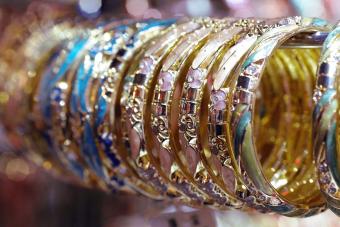
With their exquisite detail and bright colors, cloisonné jewelry pieces are miniscule works of art. For centuries, jewelers have used this ancient process of applying colored enamel to metal in order to create spectacular bracelets, pendants, earrings, and more. Today, this type of jewelry enjoys enduring popularity.
Cloisonné Jewelry Basics
Cloisonné jewelry is colorful and intricately detailed. In this amazing work, small metal filaments separate different colors of enamel. Patterns range from simple flowers or vines to animals, trees, elaborate scenes, and much more. You'll find this amazing technique on everything from bangle bracelets to individual beads.
Understanding the Cloisonné Technique
According to Fire Mountain Gems, the cloisonné technique may date back to 1800 BC in Egypt. Originally, the process involved fusing gems to metal, but this quickly transitioned to melting brightly colored glass powder or enamel onto the metal surface. The name "cloisonné" comes from the French word for "enclosed." Like tiny stained glass windows, the various colors of enamel are separated by bits of metal.
In order to create these separate compartments, jewelers use a technique that is similar to filigree. They solder tiny wires to the base piece to create the individual sections. Then, the artist fills the sections with the enamel powder or paste and fires the piece at a high heat to melt the enamel. Many pieces require the artist to use multiple layers of enamel, firing each layer at a lower temperature after it is applied. Polishing and metal plating complete the work.
Enduring Popularity of Cloisonné
Although this ancient art has been around for centuries, it has really only been popular among American enthusiasts for the last century and a half. According to Bard Graduate Center, consumers became enamored with this technique in the mid-1800s in France. From that time on, artists and jewelry manufacturers have used this technique to create gorgeous baubles.
Types of Pieces
The amazing detail of the cloisonné process lends itself to a variety of different jewelry types. If you're shopping for cloisonné jewelry, you'll see some of the following pieces:
- Beads - Whether available for purchase individually or strung as a necklace or bracelet, cloisonné beads offer a lovely, three-dimensional way to appreciate this art.
- Pendants and pins - Because of the intricacy of cloisonné work, this art is perfect for the focal point of a necklace or as a pin. Cloisonné pins pendants range from tiny, understated elements to large statement pieces.
- Bangle and cuff bracelets - Although you can purchase beaded cloisonné bracelets, there are also many bangle and cuff designs that use this technique too. Because the surface area is larger, long, scrolling patterns are common.
- Rings - Cloisonné rings can include enamel that goes all the way around the band, or they can feature an enameled focal point set on a metal ring shank. Some designs also mix cloisonné enamel with traditionally set gemstones.
- Earrings - Earrings can show off a cloisonné dangle or be a simple post style. Either way, they offer a fun pop of color and delicate workmanship.

Jewelry Artists Specializing in Cloisonné
Given the intricacy of this technique, there are a number of artists who specialize in cloisonné jewelry. Explore a few famous artists.
- Michael Romanik - This renowned cloisonné artist creates beautiful modern pieces inspired by nature. His brooches, pendants, earrings, and bracelets feature bright colors and images of birds, flowers, and leaves.
- Falcher Fusager - This artist and owner of MAGICK jewelry specializes in modern cloisonné designs set in gold and sterling silver. The pieces feature geometric motifs, spirals, and integrated gemstones.
- Joan Strott Alvini - Although this artist does not limit herself to the cloisonné process in her enamel work, she does produce many pieces that use the technique. You'll see cloisonné enameled earrings, rings, and pendants in her gallery.

Cloisonné Jewelry Tips
In addition to the history and artists of this famous jewelry technique, there are a few different tips to keep in mind when buying, wearing, and cleaning cloisonné jewelry.
Buying Cloisonné Jewelry
If at all possible, examine the cloisonné before buying it. Look for the following when buying.
- The surface of the piece should feel smooth. There shouldn't be any rough edges to the wires.
- Each section should be filled with enamel. You should not see sections that are lower or higher than others.
- If it is crafted from precious metal, the jewelry should be marked with the metal content.

Wearing Cloisonné Pieces
Cloisonné pieces are unique. However, they aren't going to work with every outfit. Keep these tips in mind as you wear cloisonné.
- Cloisonné looks spectacular against black since the plain, dark background allows the details and metal to shine.
- Contrast your clothing with your jewelry by wearing a simple turtleneck or a basic dress with your cloisonné pieces. This allows your jewelry to take center stage.
- Consider pairing a statement-making cloisonné bangle or necklace with simpler chains or plain bracelets. Set against the layers of simple metal, the cloisonne will stand out beautifully.
- Be careful not to overpower cloisonné pieces with busy patterns, lots of other accessories, or tons of color.
Cleaning and Caring for Cloisonné
Because it is crafted from a mixture of materials, it's important to use care when cleaning your cloisonné jewelry pieces.
- Use a very soft, lint-free cloth and plain water to clean and polish your cloisonné enameled pieces.
- If you have an antique piece of cloisonné that has cracked enamel, you'll need to have it professionally repaired. Work with a restorer that specializes in this process.
- Do not use any type of chemical or abrasive cleaner on cloisonné jewelry. The chemicals and abrasives can etch the glass.
- Do not soak cloisonné jewelry since small voids in the enamel might absorb liquid and eventually sustain damage. Similarly, do not use an ultrasonic jewelry cleaner on your cloisonné pieces.
- Store cloisonné items in separate compartments or jewelry bags to keep the delicate surface of the enamel from getting scratched by your other jewelry. When traveling, store your items in a jewelry roll or travel organizer.
Jewelry That Captures the Imagination
With its intricate, multi-colored enamel and shining metalwork, cloisonné jewelry captures the imagination. Understanding the process of making this type of jewelry can add to your enjoyment of your favorite pieces, and knowing how to select and care for cloisonné can help you ensure those pieces last a lifetime.







